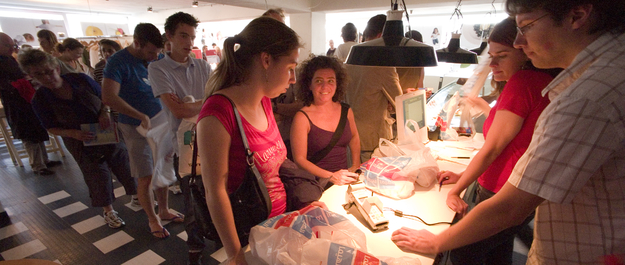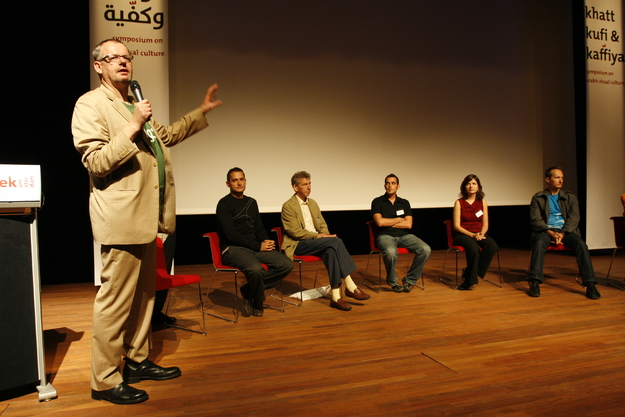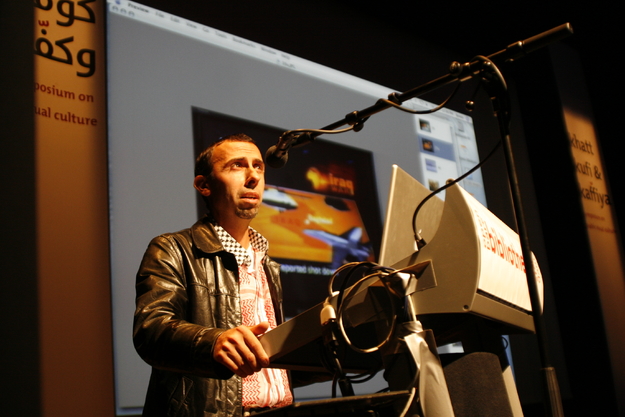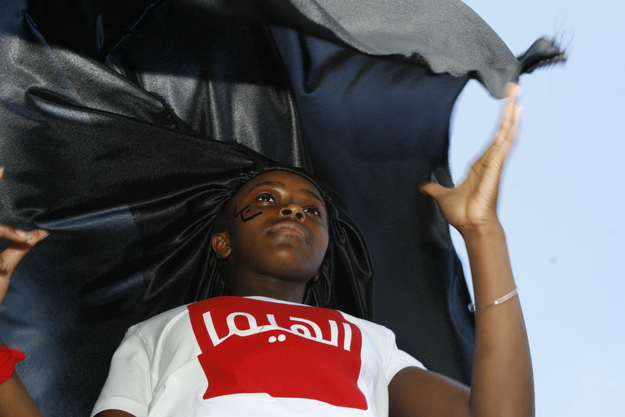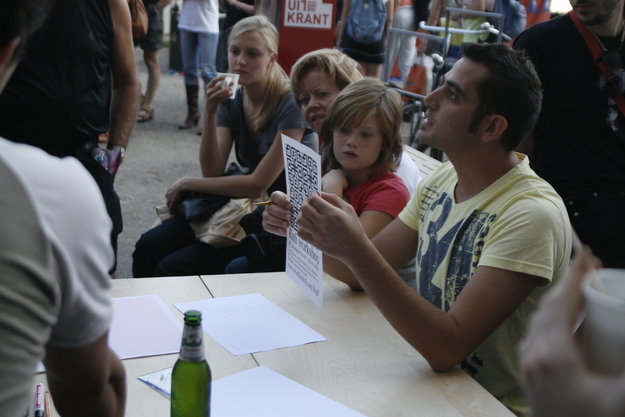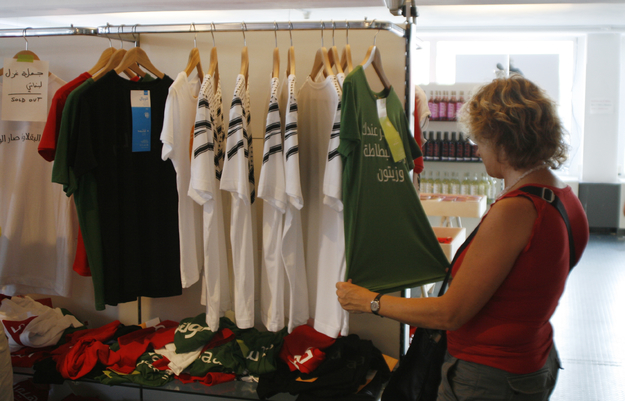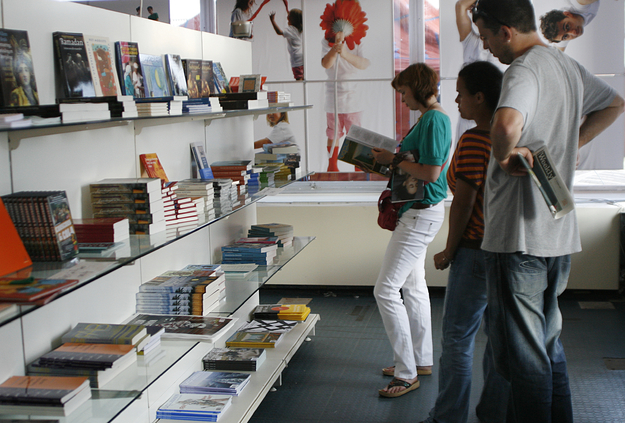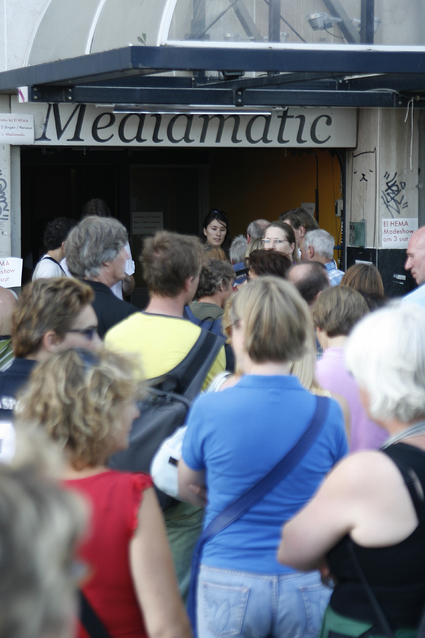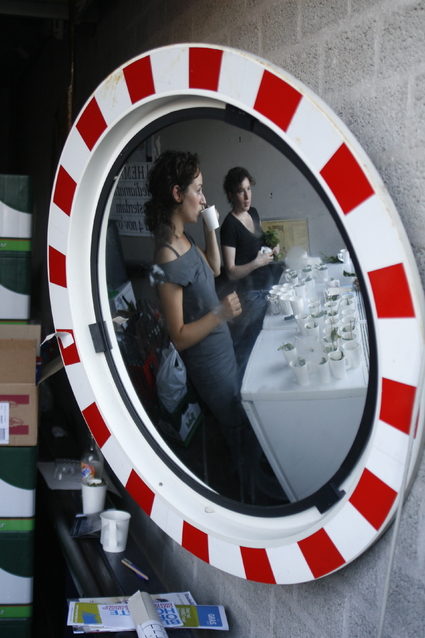The exhibit was an imaginative way to expose audiences to five new Arabic fonts, typography and culture through everyday products.
Throughout the weekend hordes of people waited in a never-ending line for at least 30 minutes to enter the Arab version of a Hema store. Organizers attributed much of the success of the event to the abundant media coverage leading up to the opening.
"Typography was on the front page of every newspaper in Amsterdam, in the news—it never happens like this. It was a historic TV moment," said Huda Smitshuijzen AbiFarès, founder of the Khatt Foundation and El Hema organizer. "I think it went very well and the success of it was beyond my expectations."
Typographer Pascal Zoghbi, who worked with Dutch designer Martin Majoor to create the Sada/Seria font on display, said this was the first time he had ever experienced this scale of coverage for an exhibit and all the people he spoke to “loved” the exhibit and conference.
Although the media coverage significantly helped promote the exhibit, one cannot deny the exceptional quality of the work on display.
"People really like what they see and what they see is design," Mediamatic Director Willem Velthoven said. "They may not be able to say where the quality comes from, but they certainly react to the product type."
Khatt Kufi Kaffiya
Before the opening at 6 p.m., more than 150 graphic designers from throughout the Netherlands, Europe and even as far as Saudi Arabia attended Khatt Kufi Kaffiya, an all-day symposium on Arab visual culture held in Amsterdam’s new public library.
Velthoven, who was equally surprised by the success of the exhibit, said the preliminary plans simply included a brief lecture and reception to celebrate the release of Typographic Matchmaking. The book describes the collaboration project of 10 Dutch and Arab typographers and their process to create the five new fonts Sada/Seria, Fresco, Fedra, Big Vesta and The Mix.
Instead of a simple local celebration “we ended up with the El Hema store and a conference,” he said.
Speakers from the Middle East, Europe and the United States of America spoke on varied subjects including “dangerous” Syrian lingerie, rebuilding the National Museum of Yemen, design and politics in Beirut, Arabic type and modern dance, among other topics.
The symposium was a means to discuss past developments in graphic design in the Arab world, as well as promote new collaborations—precisely what The Khatt Foundation Center for Arabic Typography, a non-profit organization, aims to do. The symposium was a joint venture between The Khatt Foundation and Mediamatic.
The Catwalk
El Hema could not have opened its doors without an official Arabesque fashion show displaying some of the merchandise available at the exhibit.
The models, which included the five El Hema graphic design interns, strutted down the catwalk wearing burkas and turquoise ropes around their heads as spectators, photographers and TV crews crowded around the stage snapping pictures and footage.
Upon reaching the end of the stage, a strategically placed fan blew their burkas up revealing models wearing t-shirts with Arabic pick-up lines designed by intern Abrar Al-Musallam, Arabic “I AMsterdam” t-shirts created by intern Wael Morcos, and a chosen selection from the Morecult fashion label designed by Farida Nouna and Thomas van Gelder. The crowd cheered and applauded after each burka gracefully flew up.
Choreographer Martin Butler said he developed the concept for the show after returning from a trip to Istanbul two weeks ago. While on vacation he said he saw someone step on the bottom of a woman’s burka. When she took a step forward it caused her burka to rise in the front revealing her pair of fashionable Jimmy Choo pumps.
“I wanted the [El Hema] show to be more quirky, for it to be a full unveiling,” Butler said.
The concept worked well as the day not only marked the unveiling of a new book, exhibit and clothing line, but also a glimpse into modern Arab culture.
Store Opening
After the fashion show, the excited crowd hurried inside Mediamatic’s exhibition room to experience what an Arab version of a Hema store would look like. Exhibit-goers were not allowed to buy any of the merchandise until Saturday, but were welcomed to stay for drinks and music outside the exhibit room.
Saturday, a crowd of people waited for the 12:30 p.m. opening of El Hema in order to purchase items. Exhibit-goers immediately became consumers and within half an hour a long line began to form outside that continued until closing and began again on Sunday.
"In Lebanon, nobody stands in line for t-shirts," graphic design intern Khajag Apelian said. "We didn’t expect this to happen with El Hema—it’s exciting!"
Inside parents and children ransacked the store as they searched for their favorite t-shirts, djellabas, socks, bottles of wine, books and even Halal sausages. Organizers eventually had to limit the number of t-shirts and which items customers could buy in order to keep the exhibit looking like an exhibit.
Organizers said some of the more popular items were the chocolate bars, embroidered kitchen towels, underwear and hamsa tank tops.
Inside the muggy exhibit room, attendee Karen Voors stood at the end of the long check-out line waiting to pay for a hamsa tank top and an Arabic book. She said she had been anticipating the opening of the exhibit and had even marked the date on her calendar.
"It’s a fun way of combining both cultures," she said. "People can either take it for granted or go on and think about it."
Karen Mulder who bought kitchen towels and a box of hagelslag (chocolate sprinkles) decorated with Arab patterns and designs said it would be nice if the real Hema would provide Arabesque products such as these. Both ladies agreed the designers did an excellent job of making the store look like a real Hema store.
Interns Apelian and Morcos said they were extremely happy and satisfied with the crowds’ response to their designs.
"It was our aim to make it look like Hema," Morcos said. "It’s a sign that we did it when Dutch people say that it looks like the real Hema."
